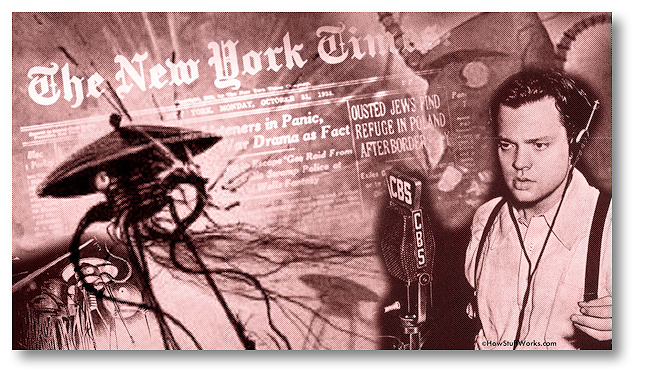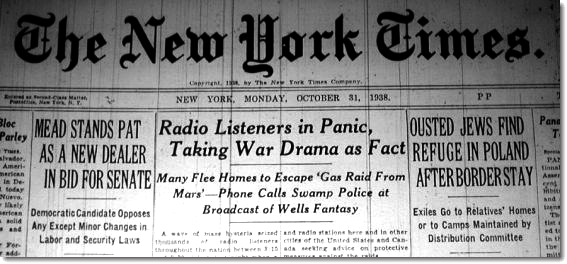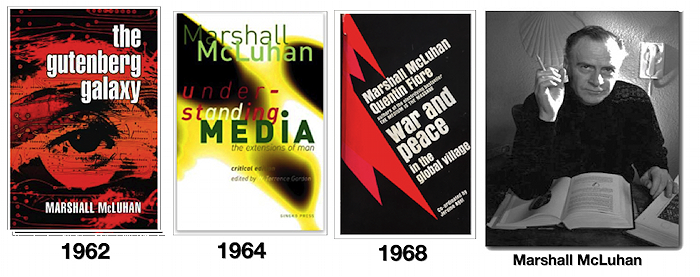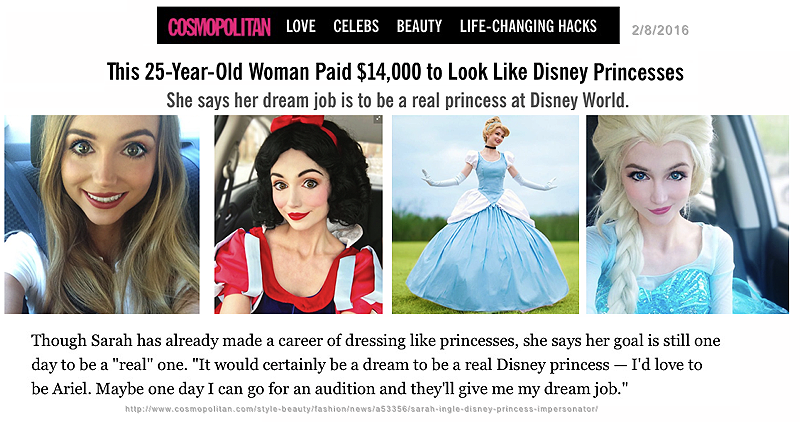PSY 355 Psychology &
Media in the Digital Age
This page was last modified on September 16, 2024
PSY 355 Psychology &
Media in the Digital Age
This page was last modified on September 16, 2024 |
Studying Psychology and Social Science:
Historical Stands & Methodological Approaches (Giles, 2003)
Early Approaches: 1930s-1960s
Orson Welles' famous "Mercury Theater of the Air": The great War of the Worlds {W} broadcast on Sunday night, October 30, 1938, at 8 pm on the CBS Radio Networkn the pre-World War II period that was not completely unexpected


A. Marshall McLuhan (1911-1980) • A Founder of the Media Ecology Stand in Media Studies

- "The Medium Is The Message"
- "The Global Village"
B. Postmodern Era ("Late Modernity" or "Late capitalism")
Jean Baudrillard (1929-2007): French sociologist, cultural theorist, & philosopher
- Simulacra and Simulation (1981)
- He claims that contemporary society has turned its back on actual reality and, using signs and symbols ("simulacra") communicated via media in general, made the human experience a simulation of reality.
- Before the Industrial Revolution
- After the Industrial Revolution, the proliferation of mass-produced copies of items
- In the postmodern world of "late capitalism" (late 20th century to today) the distinction between reality and representation breaks down much more fully. Media create completely artificial worlds ("simulacra") and sell these worlds as if they are actually real. For example, Disneyland (Anaheim, CA, 1955) & Walt Disney World (Orlando, FL, 1971)
Major Approaches to Researching the Psychology
of Media since 1960
1. The "Effects" Tradition: 1960s+
- Media seen as having negative effects, e.g., violent media & violent behavior
- Uses experimental methods:
- Albert Bandura & the Bobo Doll experiment (explanation at Simply Psychology site)
2. Cultivation Research: 1970s+ (cultivation = creating a culture)
Media is a crucial element in a complex system of environmental & cultural forces.
- George Gerbner (U. Penn, d. 2005)
- Values & cultures presented in media become commonplace all over the globe.
- Resonance = media reinforces people's daily life experiences
3. Uses & Gratification Research: late 1970s+
- Focusing upon the psychological motives of individual media consumers
- Related to Abraham Maslow's famous hierarchy of motives
- Papachrissi & Rubin (2000): Why do we go online? Motives include
- Interpersonal utility (looking for online social interaction)
- Passing time
- Seeking information
- Convenience
- Entertainment
4. Concern for the "Active" Audience
- Media dependency theory
- Focus on larger audience groups (rather than the behavior or psychology of individuals)
- What is the role of "reality television"?
- The Jersey Shore
- The Amazing Race
- Keeping Up With the Kardashians
- The Voice
- Survivor
- What kinds of outlooks and "codes" do audiences bring to "read" the media they consume?

- Fandoms & Lifestyle (to be explored more broadly by Group 1)
This page was first posted on 2/17/14